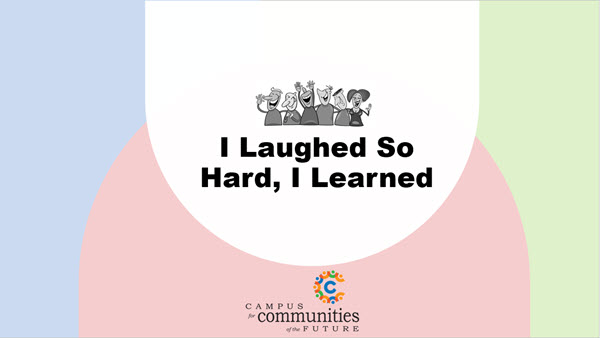Laugh and Learn?

I honestly can’t remember the last time I laughed so hard or learned so much.
Wait. Laughing and learning at the same time? Can it be? After all, I distinctly recall getting into trouble for assuming I could combine the two. Even my kindergarten teacher wrote on my report card that although I was a good student, I was inclined to be a bit too social.
While today there is a better understanding and acceptance that children learn through their play, we typically don’t equate fun and playfulness with adult learning. Perhaps we should.
The occasion was a retreat our team organized for a diverse group of participants who came together to share, learn, and celebrate their experiences as community leaders.
At first glance, outsiders looking in might have questioned the often zany and rambunctious antics and uncontrolled laughter. I’m guessing they would have been even more worried had they known it was a group of community leaders.
However, if they had looked deeper, or even read the participant post-event evaluations, they would have seen that the play and fun contributed to an environment that prompted intense listening, deep reflection, and insightful learning.
Participants worked in groups using a variety of props to prepare skits that shared their key learnings about community leadership, initiating projects, and long term planning. The learnings were profound and presented in such a humourous way that they remain stamped in our collective memories.
They also designed their own meeting agenda for topics that prompted deep and rich conversations, skipped rope to experience team building, spelled out their names with their hips in a relay designed to maintain high energy levels, experienced guided imagery that helped them envision the future of their communities, and cut and pasted remarkable vision boards to explore their own leadership.
It was a reminder for me that learning can and should be fun. Not only that, we need to think more about the factors that contribute to effective learning environments for grown-ups.
What do we need to remember when designing for adults?
We can’t forget that human beings are social creatures. Group activities contribute to the effectiveness of the learning experience.
It is also important to draw on the life experiences of adults. Making connections to the experiences of the respective participants at our retreat provided a more meaningful context for understanding the theory and knowledge of change, thereby facilitating important learning.
Especially for kinesthetic learners, learning by doing is also important. Practicing by sharing and then teaching others is a sound strategy for reinforcing learning.
We’ve also learned to be flexible. While the core outcomes of the learning we wanted to convey were always clear and focused, the edges were deliberately fuzzy allowing us to adapt and respond to the needs of the participants.
But perhaps the most important element of an effective learning environment is that of play. When it is fun, participants are more receptive to the learning. Additionally, but perhaps just as key, play connects us to others. Sharing joy and laughter promotes bonding and a sense of community. Play stimulates our imagination and curiosity and often results in more creative solutions. When we connect with others through play we are also reminded that we are not alone.
Beyond all these excellent reasons for playing, there is simply the sheer joy of it. Play is a state of being that is happy and joyous.
Several years after that retreat, I can still recall the fun and play that did so much to amplify everyone’s community leadership skills as well as our hearts and spirit.
Posted on 11-17-23Next entry: We Are So Much More Than a Non-Horse
Previous entry: They See Possibilities, Not Problems

 Brenda Herchmer is the owner of Grassroots Enterprises, a community development consulting company.
Brenda Herchmer is the owner of Grassroots Enterprises, a community development consulting company.